To read a spoiler-free review of Pushing Ice, click here.
For some spoiler-filled thoughts about the very end of the book, go ahead and read more…
To read a spoiler-free review of Pushing Ice, click here.
For some spoiler-filled thoughts about the very end of the book, go ahead and read more…
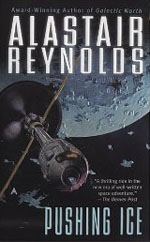 Pushing Ice is basically Alastair Reynolds’ attempt to take the sequels to Rendezvous with Rama, scratch off the serial numbers, and rewrite them so that they don’t suck as much.
Pushing Ice is basically Alastair Reynolds’ attempt to take the sequels to Rendezvous with Rama, scratch off the serial numbers, and rewrite them so that they don’t suck as much.
In this, he succeeds. Although, honestly, that’s a pretty low bar to clear.
Warning: The spoilers in this reaction will contain deeper spoilers than most of my reactions. In general, I follow a policy of not spoiling content beyond the first 50 pages of the book. That will not be the case with Pushing Ice.
Isolating the strengths and weaknesses of the book is actually rather challenging. Reynolds lacks consistency throughout his narrative, often soaring to compelling heights only to crash back to mediocre depths.
For example, as a re-imagining of the Rama milieu, the first challenge for Pushing Ice is the creation of the Big Dumb Object (BDO). The initial conceptual strokes of the BDO are absolutely riveting: Without any warning, Janus — one of the icy moons of Saturn — suddenly starts accelerating out of the solar system. Unbeknownst to any of us, an alien spaceship had been masquerading as the entire moon for countless eons.
But when the main characters actually reach the BDO, the details are shoddy and underdeveloped. Reynolds paints with a broad and unfocused brush: We’re told repeatedly how “strange” and “enigmatical” Janus is, but we’re never shown any of the details necessary to really bring the place to life.
But then Reynolds turns it around again: The first BDO leads them to an even bigger BDO, and that BDO — and the larger mechanism it’s part of — is really fascinating. And the revelations of its true nature are not only continued until the end of the book, but beyond it (as I believe Reynolds is subtly hinting at something that even his own characters don’t realize).
One of the areas where Pushing Ice dramatically improves on the Rama sequels are the interpersonal dramas of the main characters. To put it succinctly: Instead of being derived from cheesy soap operas, they’re truthful and meaningful.
Even here, however, Reynolds has consistency problems. For example, the central drama of the novel revolves around the schisming friendship of Bella and Svetlana. Reynolds is attempting to create a dynamic in which two people can both vehemently disagree with each other and both be right from their own point of view.
And if he had actually pulled it off (as he comes tantalizingly close to doing), the result would be absolutely breathtaking.
Unfortunately, it doesn’t work. Largely because he resorts to both protagonists being inexplicably idiotic.
Sittuation #1:
SVETLANA: I think the company is hacking into our computer systems and altering the data. But I found a backup that they forgot to change. Here it is.
BELLA: Okay, I have my doubts. So what I’m going to do is tell the corporation exactly where the backup data is that you’re claiming they forgot to change is. Then I’ll wait awhile. Then I’ll go and check it to see if it says what you claim it says.
SVETLANA: Wait… what?
BELLA: My god! It no longer says what you claim it said! You’re lying to me!
Okay. That’s pretty bad. But it gets worse.
Situation #2:
BELLA: I’ve decided that you were right all along. Now that I believe you, I’m using the true version of the data that you brought to me to conclude that our only possible course of action is X.
SVETLANA: Well, I hate you. And so I think we should do not-X!
BELLA: You mean the course of action which, if you weren’t lying to me before, would mean our inevitable death?
SVETLANA: Yup.
And silliness ensues.
I mean, I’m obviously supposed to take it all seriously. But when you set up this Titanic Clash of Wills(TM) in which both characters are mentally deficient… well, it’s a little hard to take them seriously.
The end result of all this is a book which I found both compelling and frustrating in almost equal measures. It was a book that could both keep me up into the wee hours of the morning frantically turning pages, and simultaneously a book that would leave me slamming the covers shut in disgust.
In the final analysis, Pushing Ice is a thoroughly mediocre book that could have been (and should have been) great. This puts it one step up the rung from the dreadful Rama sequels (which are thoroughly awful books that could have been great), but there’s still too much dross to dig through to find the good bits (which are, at times, very, very good).
GRADE: C-
Alastair Reynolds
Published: 2006
Publisher: Ace
Cover Price: $8.99
ISBN: 0441015026
Buy Now!
For additional comments on Pushing Ice, which include SPOILERS, click here.
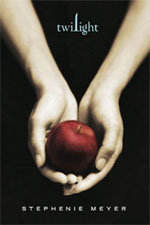 Over the past 20 years there has been a fascinating trend in vampire fiction. Ever since Anne Rice’s Vampire Chronicles crystallized the sub-genre, there has been a steady and seemingly inexorable trend towards systematically stripping vampires of their traditional weaknesses: Garlic and running water were the first to vanish, but holy symbols were quick to follow. It wasn’t long before they were able to cast reflections and even sunlight was downgraded from an instant sentence of death to a minor inconvenience before eventually being phased out entirely. Murderous, bloodthirsty beasts? Not so much. I mean, sure, they might get peckish once in awhile, but even that hunger is easily sated by a visit to the local blood bank or sucking a few rats dry.
Over the past 20 years there has been a fascinating trend in vampire fiction. Ever since Anne Rice’s Vampire Chronicles crystallized the sub-genre, there has been a steady and seemingly inexorable trend towards systematically stripping vampires of their traditional weaknesses: Garlic and running water were the first to vanish, but holy symbols were quick to follow. It wasn’t long before they were able to cast reflections and even sunlight was downgraded from an instant sentence of death to a minor inconvenience before eventually being phased out entirely. Murderous, bloodthirsty beasts? Not so much. I mean, sure, they might get peckish once in awhile, but even that hunger is easily sated by a visit to the local blood bank or sucking a few rats dry.
The root for the trend was obvious: Vampires are alluring. They have the handsome, civilized polish of Mr. Darcy with a dark edge of bad boy danger. And this appeal moved them steadily from them villains to anti-heroes to heroes and, from there, to romantic leads. The result may be a rather bland creation with only the faintest glimmerings of moral and ethical complexity that was once inherent to the vampire mythos (the typical vampire these days has all the moral conflict of Superman eating a Big Mac), but the motivation was also crystal clear.
What’s interesting in reading Stephanie Meyer’s Twilight is seeing what is, in retrospect, the perfectly logical progression of the trend: Having systematically stripped vampires of their weaknesses, the genre had no choice but to start giving them new bling.
And thus we end up with vampires who literally sparkle in sunlight while being gifted with various assortments of psychic powers.
FIRST IMPRESSIONS
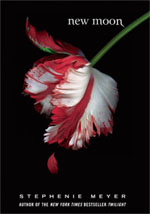 Okay, quick concept summary for the three people who have no idea what the Twilight Saga is: Isabella Feyfucker moves from the sunny world of Phoenix, AZ to the cold, rainy climes of a small town in the Pacific Northwest. Once there, she becomes the romantic center of attraction for every paranormal male in a 500-mile radius. Particularly Edward Cullen (a vegetarian vampire) and Jacob (a werewolf).
Okay, quick concept summary for the three people who have no idea what the Twilight Saga is: Isabella Feyfucker moves from the sunny world of Phoenix, AZ to the cold, rainy climes of a small town in the Pacific Northwest. Once there, she becomes the romantic center of attraction for every paranormal male in a 500-mile radius. Particularly Edward Cullen (a vegetarian vampire) and Jacob (a werewolf).
Stephanie Meyer makes it very easy to dismiss her work as that of a talent-less hack. Her prose is crude. Her plotting is uneven and often nonsensical. Her world-building is simplistic and inconsistent. In short,her books simply exude a sense of either carelessness or incompetence or both.
For example, in New Moon Meyer very specifically establishes that it’s the latter half of February (within one or two weeks of Valentine’s Day). Bella wants to sneak out of the house to go hiking and she’s excited when she discovers that her father is planning to go ice-fishing on the river. So far, everything tracks. But when she reaches the woods:
The forest was full of life today, all the little creatures enjoying the momentary dryness. Somehow, though, even with the birds chirping and cawing, the insects buzzing noisily around my head, and the occasional scurry of the field mice through the shrubs, the forest seemed creepier today…
Well, of course it seems creepier! You’ve left your father ice-fishing in the middle of winter and entered some sort of Twilight Zone Narnia featuring eternal summer!
A few paragraphs later Meyer has added “chest-high ferns” (a well-known winter growth) and a “bubbling stream” (which has inexplicably failed to join the river in freezing over) just to maximize the surrealism of the scene.
In the big picture, this continuity gaffe is of relatively minor importance. But Meyer strews this stuff all over her apparently unrevised, unedited, and unread manuscript. And it’s not just the minor stuff, either. Major plot points often fall prey to the same traps.
It was particularly interesting to watch the Twilight movie after reading the books: Meyer’s fanbase screamed bloody murder about a number of minor changes which had “ruined the movie”, but ironically these changes almost universally fixed the fundamental flaws in Meyer’s novel.
For example, in the novel Meyer gets about four-fifths of the way through the book before suddenly realizing that she doesn’t have an ending. To “solve” this problem she has three vampires show up out of nowhere. One of them decides to harass Bella just ’cause he can, Edward kills him, and… that’s it. End of novel. These vampires have no connection to the rest of the narrative, but apparently because there’s a fight the story can be over.
The film doesn’t change much: It just adds a couple of extra scenes in the first three-quarters of the movie to establish these evil vampires as a persistent background threat. But the result is a narrative which actually holds together instead of falling apart.
The film is also remarkably successful in turning Bella’s classmates — who are uniformly bland, forgettable cardboard in Meyer’s novels (to the degree that they quietly fade away in the sequels) — into quirky, memorable characters.
I bring this up only to demonstrate how little effort (or skill) it would take on Meyer’s part to fix many of the most egregious flaws in these novels.
THE SILVER LINING
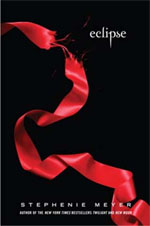 So if these books are so painfully flawed, why did I keep reading them?
So if these books are so painfully flawed, why did I keep reading them?
Because Meyer is not, in fact, a talent-less hack. To the contrary: She has one particularly exceptional talent that I feel fairly safe in saying is the reason she’s now a multi-millionaire and her books have become cultural icons.
While Meyer’s secondary characters are nothing more than interchangeable cardboard, Meyer’s handling of her central cast of characters is adept. I would even describe it as gifted. Bella, Edward, and Jacob leap off the page. They breathe. They live.
Are they foolish? Unstable? Irrational?
Absolutely. And it’s easy to make fun of them for that. But there are plenty of foolish, unstable, and irrational people in the real world. Meyer simply captures them in narrative form and then, through the application of the supernatural, she adoitly elevates these all-too-human characters into a mythical plane.
Are those supernatural elements nothing more than a cliched reworking of the vampire-and-werewolf cultural gestalt created by White Wolf’s World of Darkness? Sure. But it doesn’t matter. The mythic elements of Meyer’s milieu don’t need to be particularly original in order to heighten the reality of her characters.
So, basically, you have the powerful alchemy of teen romance with the dial cranked up to 11. That, by itself, is basically paint-by-numbers. What can’t be trivially duplicated is the potent reality of Meyer’s characters. With that added to the mix, the result is explosive.
It’s a pity that this gemstone is mired in the muck of Meyer’s weakness as a writer, but the jewel itself glitters no less brightly. And it’s not surprising to me that these books were able to capture the imagination of a generation of teenage girls.
THE DEEPER PROBLEMS
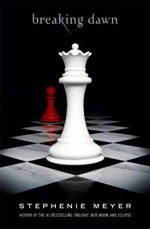 There has always been something vaguely disturbing in the sub-genre of vampire romances: Holding up the “dangerous man that I can change through the power of love” as some sort of romantic ideal is certainly a popular trope, but not a healthy one. On the other hand, while Meyer doesn’t precisely deal with these issues, she does manage to avoid some of the thornier patches of the sub-genre.
There has always been something vaguely disturbing in the sub-genre of vampire romances: Holding up the “dangerous man that I can change through the power of love” as some sort of romantic ideal is certainly a popular trope, but not a healthy one. On the other hand, while Meyer doesn’t precisely deal with these issues, she does manage to avoid some of the thornier patches of the sub-genre.
But where the series gets particularly creepy are the sequels. In New Moon, Edward suddenly embraces hardcore emotional abuse as his modus operandi. And then, in Eclipse — as if Meyer were checking off abusive relationships on a To Do list — Edward goes for full-on stalker. Whether it’s literally disabling Bella’s car so that she can’t go where she wants to go or the constant variants of “I only hurt you because I love you, baby” that he mouths, the warning sirens were screaming.
As if to emphasize Edward as a co-dependent, abusive stalker, Meyer simultaneously establishes a second love interest in the werewolf Jacob. Jacob is everything Edward isn’t: Emotionally available. Stable. Supportive. And, thus, completely rejected by Bella as anything more than a good friend (who she can’t see because her jealous boyfriend forbids it).
In Breaking Dawn, the abusive nature of the relationship drains away. But while it made for a more enjoyable reading experience, in retrospect it’s equally creepy: The subtext appears to be that marriage is a magical cure-all. Having problems with an abusive boyfriend? Get married and he’ll start treating you better!
Ironically, Meyer’s strengths as an author only serve to make the Edward-Bella relationship even creepier. She writes Bella with an absolute truthfulness, detail, and depth that seems to fully capture the psychological mire of someone caught in an abusive relationship. In other circumstances, one could hold this up as a literary triumph. But the narrative never presents itself as a the gut-wrenching tale of a girl trapped in a co-dependent tragedy. Meyer is writing a self-destructive horror story, but she thinks she’s writing about exemplary True Love. It’s sad, disturbing, and rather disgusting.
GRADES:
TWILIGHT: C-
NEW MOON: C
ECLIPSE: C
BREAKING DAWN: B-
Stephanie Meyers
Published: 2005 / 2006/ 2007 / 2008
Publisher: Little, Brown and Company
Cover Price: $10.99
ISBN: 0316038377 / 0316075655 / 031608736X / 031606792X
Buy Now!
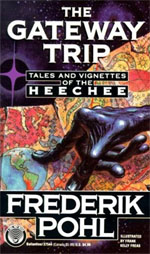 The Gateway Trip is purportedly a collection of short stories subtitled Tales and Vignettes of the Heechee.
The Gateway Trip is purportedly a collection of short stories subtitled Tales and Vignettes of the Heechee.
But that’s pretty much bullshit.
This book would be more accurately titled A Child’s History of Gateway. Only the last eight pages deal directly with the Heechee to any meaningful degree, while most of the rest of the book is largely a recapitulation of the Future History which is already thoroughly explained in the other Gateway books. This blatant regurgitation of exposition is occasionally studded with short segues describing the missions of various Gateway prospectors, but these are passionless, short (averaging perhaps 5 paragraphs), and read like the informational placards at a rather bland museum.
(I would have dearly loved to have either: (a) A true collection of stories focusing entirely on the Heechee; or (b) a collection of short stories focusing on various Gateway-based prospectors. Sadly this book is neither. It’s a completely wasted opportunity.)
The only exception to this pointless pablum is “The Merchants of Venus”, a novella originally published in 1972 which serves as a prequel of sorts for Gateway. I found “The Merchants of Venus” to be a very entertaining yarn of Campbellian science fiction. The occasional tinge of sexism by way of golden age SF is cringe-worthy, but beyond that the three main characters are well-drawn; the milieu is evocative; and the hard science fiction is used dramatically (rather than self-indulgently).
In short, if you can find a copy for a couple of bucks, The Gateway Trip is worth it just to have a copy of “The Merchants of Venus” (particularly if you enjoyed Gateway and want to find the only other taste of the universe that’s worth paying any attention to). But it’s probably best if you just skip the rest of it.
GRADE: D
(Merchants of Venus gets a B-.)
Frederik Pohl
Published: 1991
Publisher: Del Rey
Cover Price: $6.99
ISBN: 0345375440
Buy Now!
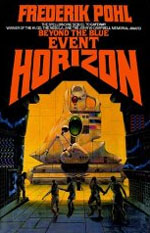 The first sensation I had while reading the sequels to the exemplary Gateway was one of disjointedness.
The first sensation I had while reading the sequels to the exemplary Gateway was one of disjointedness.
First, the narrative of Beyond the Blue Event Horizon jerks around in an uneven fashion. It’s one of those books where (a) there are multiple protagonists; (b) sometimes nothing interesting will be going on with one of those protagonists; but (c) the author feels compelled to periodically spend a chapter telling you about all the non-interesting stuff happening to that protagonist as if some sort of Equal Time for Equal Narrators (ETEN) lobby existed.
Second, the book is jarringly different from its predecessor. At first it feels as if it might be the different main characters or the different narrative focus creating the disparity, but eventually I figured out what was really going on.
Pohl switched genres.
The gritty, hard science fiction of Gateway is abruptly replaced with Golden Age Space Opera studded with Heinlein heroes. The fallible and interesting Robin Broadhead of Gateway is transmogrified into the Richest Man in the Universe married to the Beautiful Super Model Who Is Also A Genius. Together they fight crime and single-handedly solve all of the galaxy’s problems. Even the most ultimate and terminal of setbacks only result in giving the main characters superpowers.
Even this, by itself, wouldn’t necessarily be catastrophic. Unfortunately, it’s badly written space opera. This is Heinlein fan fiction by way of the brain eater.
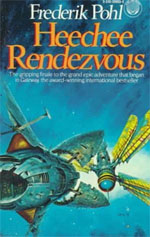 The entirety of Heechee Rendezvous, for example, consists of absolutely nothing important happening. A bloated cast of characters go caterwauling around the galaxy, but they never seem to actually accomplish anything. The entire “plot” of the novel, in fact, appears to be leading up to nothing more than a “surprise revelation”… which might make some sense, if it wasn’t for the fact that the “surprise” had already been revealed at the end of the last book. (It’s as if someone made Citizen Kane 2 as a film entirely focused around revealing to the audience that Rosebud is… wait for it… a sled.)
The entirety of Heechee Rendezvous, for example, consists of absolutely nothing important happening. A bloated cast of characters go caterwauling around the galaxy, but they never seem to actually accomplish anything. The entire “plot” of the novel, in fact, appears to be leading up to nothing more than a “surprise revelation”… which might make some sense, if it wasn’t for the fact that the “surprise” had already been revealed at the end of the last book. (It’s as if someone made Citizen Kane 2 as a film entirely focused around revealing to the audience that Rosebud is… wait for it… a sled.)
Pohl’s aping of Heinlein’s brain eater years includes his beautiful-and-brilliant protagonists having lots and lots of sex. Not because this has any relevance to the plot or elucidates the characters in any way, but just because Pohl really likes to tell us about all the hot, hot sex that his Mary Sues are having. It starts out puzzling, becomes annoying, and then resolves into boring.
The mysterious and enigmatic Heechee themselves are transformed into nothing more than a momentary (and largely irrelevant) speed bump for the Heroes to cruise over. This is part and parcel of the switch to over-the-top space opera (conforming to the “Humans Are the Awesomest Awesome That Ever Awesomed” branch of the genre), but is nonetheless a terrible, squandering waste of one of the most intriguing and evocative creations of the genre.
In many ways, Pohl’s failure with the Gateway sequels is very similar to Arthur C. Clarke’s failure with the Rendezvous with Rama sequels (except that Pohl doesn’t have a hack co-author to shoulder the blame). The first volume of each series is a beautiful exercise in engima, creating evocative riddles that provocatively suggest the contours of their solutions without ever providing concrete answers. They force every reader to provide their own closure to the questions they raise, creating an endless panoply of possible truths.
The sequels attempt to provide the definitive answers to every single question and (perhaps predictably) fail.
Perhaps it would be impossible to provide any answer as satisfactory as the non-answers we create for ourselves in reading the first books. But if they were going to try to answer those questions, I wish they’d come up with something more than vanilla pablum that could be found in dozens of other science fiction books before and since. You’ve got a blank check: Take some risks.
The only questions Pohl doesn’t try to answer in the Gateway sequels are those which he has apparently forgotten about. For example, in Gateway a relatively big deal is made out of a golden spiral device in the Heechee vessels — it lights up with sparkling light when the ship reaches the mid-point of a journey and gets hot at seemingly other random times. Nobody knows what it does, exactly, but everyone is very curious about what its true purpose might be.
In the sequels, however, it becomes nothing more than an indicator light and the mystery of its “true purpose” is completely forgotten.
But these types of raggedly hanging loose ends are just a rather specific example of a wider problem in the books: Huge, gaping continuity errors are to be found everywhere. Within any given volume these errors are usually of only a minor sort, but between volumes the Gateway sequels fail to have any sort of consistency. For example, in the last five pages of Heechee Rendezvous you are authoritatively told that characters X and Y have gone to location A. Within the first five pages of the next book, only character X has gone to location A and character Y has instead been killed off-screen in a helicopter accident. Similarly, an entire ship full of people is miraculously resurrected because Pohl apparently forgot that he killed them all in the previous book.
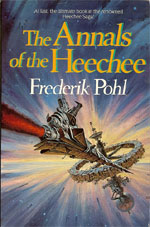 These books are, in the final analysis, a complete and utter failure. By the time The Annals of the Heechee blatantly breaks the fourth wall, thus shredding any credibility the books have left, the sequels have already firmly established themselves as the literary equivalent of Highlander 2: Exercises in mediocrity interrupted only by stretches of atrocious self-indulgence which you would be well-advised to avoid even on their own sub-par merits. At the same time, they are the sort of work whose existence you must scour from your own mental reservoirs in order to enjoy the excellent work which lamentably gave them birth.
These books are, in the final analysis, a complete and utter failure. By the time The Annals of the Heechee blatantly breaks the fourth wall, thus shredding any credibility the books have left, the sequels have already firmly established themselves as the literary equivalent of Highlander 2: Exercises in mediocrity interrupted only by stretches of atrocious self-indulgence which you would be well-advised to avoid even on their own sub-par merits. At the same time, they are the sort of work whose existence you must scour from your own mental reservoirs in order to enjoy the excellent work which lamentably gave them birth.
The fact that Gateway is a better novel than Highlander is a movie only makes it worse.
And the quality of the Gateway sequels continues to deteriorate from one volume to the next.
For example, I have a pet peeve about authors who feel the need to summarize the plots of the previous books in a series. First, it is unlikely that anyone is picking up Book 3 of a seven book series without having already ready Book 1 and Book 2. Second, the little snippets of information presented in awkward expository lumps they do include are insufficient to the task of bringing new readers “up to speed” — which means that (a) the extant readers are bored and (b) the new readers are still lost.
Some authors in series with less tightly-woven continuity do an excellent job of incorporating such details through the simple expedient of writing each book as if it were a stand-alone narrative. One of the tricks here is that they don’t try to summarize the plots of other books. Instead they simply drop in the necessary details from their protagonists past lives just as they would with any such detail. The difference is subtle and requires a certain mastery of your craft. Bujold, for example, has practically perfected the technique.
Pohl, unfortunately, has not.
What begins as a predictable drag on the narrative pace of the books eventually becomes something ludicrously disastrous: My copy of The Annals of the Heechee is 275 pages. Despite this brief length, 100 of the first 120 pages are spent finding clumsy ways to reiterate the narrative from the previous three books. And much of this material is studded with the familiar (yet baffling) errors of continuity.
Combined with the fact that Pohl treats his readers like idiots (by repeating the same bits of exposition over-and-over again just in case we missed it the first time) and structures his narratives around solving “mysteries” by revealing things that he he already revealed in the previous book the entire series quickly becomes completely interminable.
In short: Yes, that is an actual F- on The Annals of the Heechee. It deserves it.
GRADES:
BEYOND THE BLUE EVENT HORIZON: C-
HEECHEE RENDEZVOUS: D-
THE ANNALS OF THE HEECHEE: F-
Frederik Pohl
Published: 1980 / 1984 / 1987
Publisher: Del Rey
Cover Price: $14.95
ISBNs: 0765321777 / 0345300556 / 0345325664
Buy Now!